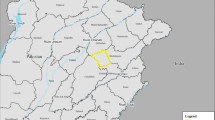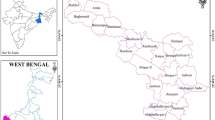Abstract
Groundwater is one of the most important water resources, with varying quality and quantity. It is extremely difficult to recycle contaminated groundwater. As a result, protecting groundwater from contamination is critical. Industrial and municipal wastes, agricultural contamination owing to pesticides and chemical hazards, seawater intrusion in coastal areas, and other factors damage groundwater. The objective of the study is to assess the groundwater quality vulnerability using the DRASTIC model with a geoinformatics approach in Surat and its surroundings. Depth of water, Net recharge, Aquifer, Soil, Topography, Impact of the vadose zone, and Hydraulic conductivity are the parameters to be considered for assessing the vulnerability using the DRASTIC model. In this study, all parameters are weighted by conventional weights. The study shows that almost 53.46% of the total study area is under moderate vulnerability, and 46.54% of the area is under high vulnerability. Olpad, Kamrej, chorasi, Surat city, and the lower part of Bardoli talukas are coming under high vulnerability, whereas other parts are coming under moderate vulnerability. It is observed that the parameters like net recharge, impact of the vadose zone, depth to the water table, and aquifer media are largely affected by high vulnerability. The study delineates groundwater vulnerability in the study area, which can help land-use policies and norms for activities connected to recharge and seepage concerning the current status of groundwater vulnerability and quality. This study helps policymakers and local authorities in taking protective measures for groundwater quality.
Similar content being viewed by others
References
Abdullah, T.O., Ali, S.S. and Al-Ansari, N. A. (2016) Groundwater assessment of Halabja Said Sadiq Basin, Kurdistan region, NE of Iraq using vulnerability mapping. Arabian Jour. Geosci., v.9(3), pp.223.
Abraham, S., Huynh, C. and Vu, H. (2020) Classification of soils into hydrologic groups using machine learning. Data, v.5(1), pp.2.
Aller, L. (1987) DRASTIC: a standardized system for evaluating groundwater pollution potential using hydrogeologic settings. Robert S. Kerr Environmental Research Laboratory, Office of Research and Development, US Environmental Protection Agency.
Ali, S.S. (2007). Geology and hydrogeology of Sharazoor-Piramagroon basin in Sulaimani area, northeastern Iraq. Unpublished Ph.D. thesis, Faculty of Mining and Geology, University of Belgrade, Serbia. 317p.
Barbulescu, A. (2020) Assessing groundwater vulnerability: DRASTIC and DRASTIC-like methods: a review. Water, v.12(5), 1356.
Central Ground Water Board (2020) G.o.I., Ministry of Jal Shakti, Department of Water, RD & GR, Groundwater Year Book 2019–20
Ankit N. Chaudhari, Darshan J. Mehta, Neeraj D. Sharma (2021) An assessment of groundwater quality in South-West zone of Surat city. Water Supply, v.21(6), pp.3000–3010. doi:https://doi.org/10.2166/ws.2021.083.
Ankit N. Chaudhari, Darshan J. Mehta, Neeraj D. Sharma (2022) Coupled effect of seawater intrusion on groundwater quality: a study of South-West zone of Surat city. Water Supply, v.22(2), pp.1716–1734. doi:https://doi.org/10.2166/ws.2021.323.
Chowdary, V.M., Rao, N.H. and Sarma, P.B.S. (2005) Decision support framework for assessment of non-point-source pollution of groundwater in large irrigation projects. Agricul. Water Managmt., v.75(3), pp.194–225.
CGWB (2013) Annual Report on Groundwater Quality for Surat District, Gujarat, India.
Foster, S.S.D. (1987) Fundamental concepts in aquifer vulnerability, pollution risk, and protection strategy.
Foster, S.S.D. (1998) Groundwater recharge and pollution vulnerability of British aquifers: a critical overview. Geol. Soc. London, Spec. Publ., v.130(1), pp.7–22.
Foster, S., Hirata, R., Gomes, D., D’Elia, M., Paris, M. (2002) Groundwater quality protection. Washington, DC, The World Bank
Gleick, P. H. (1993) Water and conflict: Fresh water resources and international security. International security, v.18(1), pp.79–112.
Khakhar, M., Ruparelia, J. P., & Vyas, A. (2017). Assessing groundwater vulnerability using GIS-based DRASTIC model for Ahmedabad district, India. Environ. Earth Sci., v.76(12), pp.1–18.
Mehta, V.K., Walter, M.T., and DeGloria D.S. (2006) A simple water balance model. Cornell University, technical report No.5, 9p.
Morris, B.L., Lawrence, A.R., Chilton, P.J.C., Adams, B., Calow, R.C. and Klinck, B.A. (2003) Groundwater and its susceptibility to degradation: A Global Assessment of the Problem and Options for Management. Early Warning and Assessment Report Series, RS. 03–3, United Nations Environmental Program, Nairobi, Kenya, 126.
National Research Council. (1993) Ground water vulnerability assessment, contamination potential under conditions of uncertainty. National Academy Press, Washington DC.
Narendra, K. and Rao, K.N. (2006) Morphometry of the Meghadrigedda watershed, Visakhapatnam district, Andhra Pradesh using GIS and Resource sat data. Jour. Indian Soc. Remote Sens., v.34(2), pp.101–110.
Ozha, D.D., Varshney, C.P. and Bohra, J.L. (1993) Nitrate in ground waters of some districts of Rajasthan. Indian Jour. Environ. Health, v.35, pp.15–19.
Panagopoulos, G. P., Antonakos, A. K., & Lambrakis, N. J. (2006). Optimization of the DRASTIC method for groundwater vulnerability assessment via the use of simple statistical methods and GIS. Hydrogeol. Jour., v.14(6), pp.894–911.
Piscopo, G. (2001) Groundwater vulnerability map explanatory notes Castlereagh catchment. Centre for natural resources, NSW department of land and water conservation, Parramatta
Report on “Physical and Chemical Properties of Red and Black Soils of Selected Benchmark Spots for Carbon Sequestration Studies in Semi-Arid Tropics of India”, CRIDA, IISS and NBSS&LUP, 2007.
Rosen, L. (1994). A study of the DRASTIC methodology with emphasis on Swedish conditions. Groundwater, v.32(2), pp.278–285.
Rundquist, D.C., Peters, A.J., Di, L., Rodekohr, D.A., Ehrman, R.L. and Murray, G. (1991) Statewide groundwater vulnerability assessment in Nebraska using the drastic/GIS model. Geocarto Internat., v.6(2), pp.51–58.
Shirazi, S.M., Imran, H.M., Akib, S., Yusop, Z. and Harun, Z.B. (2013) Groundwater vulnerability assessment in the Melaka State of Malaysia using DRASTIC and GIS techniques. Environ. Earth Sci., v.70(5), pp.2293–2304.
Siebert, S., Burke, J., Faures, J. M., Frenken, K., Hoogeveen, J., Döll, P. and Portmann, F. T. (2010) Groundwater use for irrigation—a global inventory. Hydrol. Earth Syst. Sci., v.14(10), pp.1863–1880.
USGS (2010), http://ga.water.usgs.gov/edu/2010/gallery/global-water-volume.html
UN World Water Development Report 2020 ‘Water and Climate Change’
Author information
Authors and Affiliations
Corresponding author
Rights and permissions
About this article
Cite this article
Patel, P., Mehta, D.J. & Sharma, N.D. A GIS-based DRASTIC Model for Assessing Groundwater Quality Vulnerability: Case Study of Surat and its Surroundings. J Geol Soc India 99, 578–582 (2023). https://doi.org/10.1007/s12594-023-2347-4
Received:
Accepted:
Published:
Issue Date:
DOI: https://doi.org/10.1007/s12594-023-2347-4




